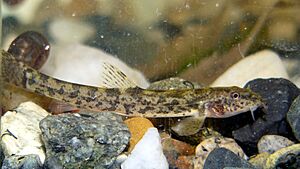Stone loach facts for kids
Quick facts for kids Stone loach |
|
|---|---|
 |
|
| Conservation status | |
| Scientific classification | |
| Synonyms | |
|
The stone loach (Barbatula barbatula) is a small, interesting fish found in fresh water across Europe. It's part of a group called ray-finned fish, and it belongs to the family Nemacheilidae. This fish loves to live among the gravel and stones in fast-moving rivers and streams.
One of the coolest things about the stone loach is the small, whisker-like feelers called barbels around its mouth. It uses these barbels to find tiny invertebrate creatures hiding in the riverbed, which are its main food. The stone loach has a body that's a mix of brown, green, and yellow colors, helping it blend in with its surroundings.
Contents
What Does a Stone Loach Look Like?
The stone loach is a small, thin fish that lives at the bottom of rivers. It usually grows to about 12 centimeters (about 5 inches) long, but some can reach up to 21 centimeters (about 8 inches). Its eyes are placed high on its head, which helps it see around while staying close to the riverbed.
It has three pairs of short barbels on its lower jaw, right below its mouth. These are super important for finding food! The stone loach has a rounded body, not very flat from side to side. Its fins, both the one on its back (dorsal) and its tail fin (caudal), are rounded with slightly notched tips.
The color of this fish is usually yellowish-brown with darker blotches and stripes. You might also see a faint dark line running from its nose to its eye. Its fins are brownish and often have light dark bands.
Where Do Stone Loaches Live?
The stone loach is a very common fish found in most parts of Europe. It prefers clear rivers and streams that have gravel and sandy bottoms. You can find them in different places like:
- Upland areas (higher ground)
- Chalk streams (rivers that flow over chalk bedrock)
- Lakes and reservoirs
The most important thing for them is that the water is well-oxygenated. Sometimes, these fish might swim into estuaries, which are where rivers meet the sea, but they don't like salty water. They spend most of their time on the bottom, often partly buried in the sand or gravel. They are most active at night, digging around for small invertebrates to eat.
You can find stone loaches in many countries, including:
- Austria
- Belgium
- Czech Republic
- Denmark
- Finland
- France
- Germany
- Hungary
- Ireland
- Italy
- Netherlands
- Poland
- Romania
- Spain
- Sweden
- Switzerland
- United Kingdom
Sadly, they are no longer found in Greece.
Stone Loach Life and Habits
Young stone loaches, called larvae and small juveniles, prefer sandy areas with slower water currents. As they grow bigger, they move to gravel bottoms where the current is faster. Adult stone loaches eat larger bottom-dwelling invertebrates like gammarids (small shrimp-like creatures) and chironomids (midge larvae), along with other insect larvae.
They usually feed at night, using their barbels to find their prey in the dark. Stone loaches can handle a bit of pollution from organic materials and changes to river channels. However, they are very sensitive to pollution from heavy metals and chemicals, and they need good oxygen levels in the water. This means that if you find stone loaches in a river, it's a good sign that the water quality is healthy!
These fish don't live very long, usually only 3 to 4 years. Living to 5 years is quite rare for them.
Reproduction and Life Cycle
Stone loaches lay their eggs over gravel or sand, or among water plants. In rivers where there isn't much food, they might only breed once a year. But in richer waters, they can breed multiple times in one season!
Female stone loaches release their eggs into the open water, often near the surface. The eggs then drift down and stick to different surfaces, sometimes getting covered by sand or bits of plants. A female stone loach can lay eggs every day for short periods. In Great Britain, they breed from April to August, and a single female can lay as many as 10,000 eggs!


